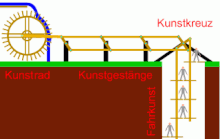Impact water
As a supplement water (rare drive water ) refers to the water, which for the propulsion of water wheels , water column machines or water turbines is used. In this case, which is the potential energy of the damming height or the kinetic energy of flowing water is converted into mechanical energy.
The impact water was of particular importance in mining because it was particularly energy-intensive. The impact water was directed to artificial tools for dewatering , shaft conveyance or driving , but also to stamp mills and Erzwäschen . For example, while paper and water mills could usually be built near natural watercourses, the impact water for mines , where no rivers with abundant water were available, often had to be brought in over many kilometers of artificial trenches and florets . In order to guarantee a continuous surcharge even in times of scarce water, the water was dammed up in artificial ponds and released when required.
The amount of impact water that was necessary to move a water wheel was specified in "wheel" or "wheel water" (also "wheel water"). Depending on the size and use of the water wheels, 1 wheel of water was 60, 100 and even up to 460 cubic feet per minute, i.e. about 1.5 to 11.5 m³ per minute. As a rule, around 5 to 7.5 m³ per minute are used.
The use of impact water in mining often meant a large investment and was mainly used where deep construction promised yield . Smaller mines, on the other hand, used reels or göpel . In the 19th century, the impact water was increasingly being replaced as drive energy by the much more effective steam engines , even if they were more expensive to purchase and maintain.
literature
- Johann Samuel Schröter : Mineralogical and mining dictionary . First volume. From A to Berg, Aufschlagwasser, S. 295 f . ( Digitized version ).
Individual evidence
- ^ News of a new, large-scale experiment on the amount of water that is lost from artificial trenches through evaporation . In: Johann Friedrich Lempe (Hrsg.): Magazin für die Bergbaukunde . tape 11 , p. 134 ( digitized version ).
- ↑ Julius Weisbach : The new art of mine cutting and its application to mining systems . tape 2 . Vieweg & Sohn, Braunschweig 1859, p. 155 ( digitized version ).
- ↑ Christian Zimmermann: The Harz Mountains described in a special relationship to natural and industrial studies . Part 2. Leske, Darmstadt 1834, p. 83 ( digitized version ).
- ↑ Wilfried Ließmann : Historical mining in the Harz . Springer, Berlin 2010, ISBN 978-3-540-31327-4 , pp. 94 .

